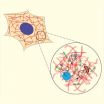(Press-News.org) Although HIV can now be effectively suppressed using anti-retroviral drugs, it still comes surging back the moment the flow of drugs is stopped. Latent reservoirs of HIV-infected cells, invisible to the body's immune system and unreachable by pharmaceuticals, ensure that the infection will rebound after therapy is terminated.
But a new strategy devised by researchers at Rockefeller University harnesses the power of broadly neutralizing antibodies against HIV, along with a combination of compounds that induce viral transcription, in order to attack these latent reservoirs of cells in an approach termed "shock and kill." In tests on mice, 57 percent of animals treated in this way did not have the expected resurgence of virus in their blood after their treatment ended.
"This is the first time that any combination of agents has been found to prevent viral rebound in any animal model," says Nussenzweig.
Three Rockefeller labs collaborated on the study: Michel C. Nussenzweig's Laboratory of Molecular Immunology; Alexander Tarakhovsky's Laboratory of Immune Cell Epigenetics and Signaling; and Jeffrey V. Ravetch's Leonard Wagner Laboratory of Molecular Genetics and Immunology. The findings are published August 14 in Cell.
The problematic latent reservoirs of HIV-infected cells are established very early in the infections, possibly even before tests can detect the presence of the virus, and current drug therapies are unable to kill the latent cells.
"The latent reservoir remains the major barrier to curing HIV-1 infection," says Nussenzweig, who is the Zanvil A. Cohn and Ralph M. Steinman Professor and a Howard Hughes Medical Institute investigator. "Our finding suggests that antibodies could play a significant role in disrupting the establishment and maintenance of the latent reservoir, which is believed to be a necessary step to curing patients of HIV-1."
The Nussenzweig lab has worked for several years on broadly neutralizing antibodies, a recently discovered subset of antibodies with an unusually high ability to recognize HIV consistently despite the virus's ability to rapidly mutate. Broadly neutralizing antibodies have shown great promise for treating HIV infection in mouse and monkey models of HIV. But by themselves they suffered the same problem that plagued other therapies: when you stop administering them, the virus rebounds.
Counterintuitively, the key to success in this instance was combining broadly neutralizing antibodies with viral inducers, compounds that prompt latent viruses to become active by promoting the transcription of their DNA. The idea is to eliminate the invisibility of the latent reservoir while simultaneously attacking the virus. More than half of the mice that received broadly neutralizing antibodies along with a cocktail of three viral inducers had no viral rebound at all, even three-and-a-half months after their last injection. (Broadly neutralizing antibodies alone, or even in combination with a single viral inducer, did not have this effect, nor did combinations of anti-retroviral drugs and viral inducers that have been attempted in the past.)
The researchers say that one reason broadly neutralizing antibodies may have succeeded where traditional drugs have failed is their ability to directly harness the power of the body's own immune system using Fc receptors, which occur on a wide variety of immune system attack cells and help them precisely target the infection.
"A big surprise in this study was the important role the Fc part of the antibody played in amplifying the potency of broadly neutralizing antibodies," says Ravetch, who is Theresa and Eugene M. Lang Professor. "Their effect in neutralizing latent reservoirs of HIV-1 was largely driven by Fc-receptor binding."
INFORMATION:
Antibodies, together with viral 'inducers,' found to control HIV in mice
2014-08-14
ELSE PRESS RELEASES FROM THIS DATE:
Researchers identify a mechanism that stops progression of abnormal cells into cancer
2014-08-14
(Boston)-- Researchers from Boston University School of Medicine (BUSM) report that a tumor suppressor pathway, called the Hippo pathway, is responsible for sensing abnormal chromosome numbers in cells and triggering cell cycle arrest, thus preventing progression into cancer.
Although the link between abnormal cells and tumor suppressor pathways—like that mediated by the well known p53 gene—has been firmly established, the critical steps in between are not well understood. According to the authors, whose work appears in Cell, this work completes at least one of the ...
Researchers develop strategy to combat genetic ALS, FTD
2014-08-14
JACKSONVILLE, Fla. — A team of researchers at Mayo Clinic and The Scripps Research Institute in Florida have developed a new therapeutic strategy to combat the most common genetic risk factor for the neurodegenerative disorders amyotrophic lateral sclerosis (ALS or Lou Gehrig's disease) and frontotemporal dementia (FTD). In the Aug. 14 issue of Neuron, they also report discovery of a potential biomarker to track disease progression and the efficacy of therapies.
The scientists developed a small-molecule drug compound to prevent abnormal cellular processes caused by a ...
Inside the cell, an ocean of buffeting waves
2014-08-14
Cambridge, Mass. – August 14, 2014 – Conventional wisdom holds that the cytoplasm of mammalian cells is a viscous fluid, with organelles and proteins suspended within it, jiggling against one another and drifting at random. However, a new biophysical study led by researchers at Harvard University challenges this model and reveals that those drifting objects are subject to a very different type of environment.
The cytoplasm is actually an elastic gel, it turns out, so it puts up some resistance to simple diffusion. But energetic processes elsewhere in the cell—in the cytoskeleton, ...
Forcing chromosomes into loops may switch off sickle cell disease
2014-08-14
Scientists have altered key biological events in red blood cells, causing the cells to produce a form of hemoglobin normally absent after the newborn period. Because this hemoglobin is not affected by the inherited gene mutation that causes sickle cell disease, the cell culture findings may give rise to a new therapy for the debilitating blood disorder.
The novel approach uses protein-engineering techniques to force chromatin fiber, the substance of chromosomes, into looped structures that contact DNA at specific sites to preferentially activate genes that regulate hemoglobin. ...
NASA sees Tropical Storm Julio now far from Hawaii
2014-08-14
Hurricane Julio moved past the Hawaiian Islands like a car on a highway in the distance, and NASA's Terra satellite captured an image of the storm, now downgraded to a tropical storm located more than 700 miles away. Julio is far enough away from Hawaii so that there are no coastal watches or warnings in effect.
On August 13 at 21:10 UTC (5:10 p.m. EDT), the Moderate Resolution Imaging Spectroradiometer of MODIS instrument aboard NASA's Terra satellite captured a visible image of Hurricane Julio moving through the Central Pacific Ocean. The visible image shows that powerful ...
EARTH Magazine: Are slow-slip earthquakes under Tokyo stressing faults?
2014-08-14
Alexandria, Va. — Tokyo, a city of more than 13 million people, has been devastated by earthquakes in the past and likely will be again. But when? And what role do ongoing slow-slip earthquakes — the kind that generally can't be felt at the surface — play in relieving or building up stress?
New research examining plate movements under Tokyo has found that since the massive magnitude-9 Tohoku earthquake and tsunami in March 2011, recurrence intervals for nondamaging slow-slip quakes beneath Japan's capital have shortened. That has left seismologists wondering if this aseismic ...
A husband's declining health could put Taiwanese women at risk for health issues
2014-08-14
PRINCETON, N.J.—The death of a spouse undoubtedly brings with it stress, anxiety and uncertainty. Now, a report by Princeton University's Woodrow Wilson School of Public and International Affairs quantifies this stress, showing how a husband's declining health could put Taiwanese women at risk for health issues.
Using data from a longitudinal sample of Taiwanese older adults, the researchers found that the more a husband suffered, the more his wife's glucose levels increased. Yet, when a wife's health was declining, her husband's levels remained the same. Being widowed, ...
High prevalence of opioid use by Social Security disability recipients, reports Medical Care
2014-08-14
August 14, 2014 – More than 40 percent of Social Security Disability Insurance (SSDI) recipients take opioid pain relievers, while the prevalence of chronic opioid use is over 20 percent and rising, reports a study in the September issue of Medical Care. The journal is published by Lippincott Williams & Wilkins, a part of Wolters Kluwer Health.
The high proportion of SSDI recipients who are chronic opioid users—in many, at high and very high daily doses—"is worrisome in light of established and growing evidence that intense opioid use to treat non-malignant [non-cancer] ...
Tropical Storm Karina forms in Eastern Pacific near Socorro Island
2014-08-14
Socorro Island in the Eastern Pacific received an unwelcome tropical visitor on the morning of August 13 when satellite data confirmed the formation of Tropical Storm Karina.
Karina strengthened from the eleventh tropical depression in the Eastern Pacific. Tropical Depression 11-E formed at 11 p.m. EDT on August 12. Just twelve hours later at 11 a.m. EDT, the depression had become better organized and winds increased to tropical storm strength.
NOAA's GOES-West satellite captured an infrared image of newborn Tropical Storm Karina approaching Socorro Island in the Eastern ...
NASA sees fragmented thunderstorm bands wrapped around Tropical Storm Karina
2014-08-14
Although Tropical Storm Karina is still strengthening in the Eastern Pacific Ocean NASA's Aqua satellite revealed a large band of fragmented thunderstorms wrapping into its center from the north.
On August 13 at 21:00 UTC (5 p.m. EDT), the MODIS or Moderate Resolution Imaging Spectroradiometer instrument aboard NASA's Aqua satellite captured a visible image of Tropical Storm Karina off the west coast of Mexico. The image showed a concentration of strong thunderstorms around the center of circulation while the band of thunderstorms to the north appeared broken. The strongest ...



